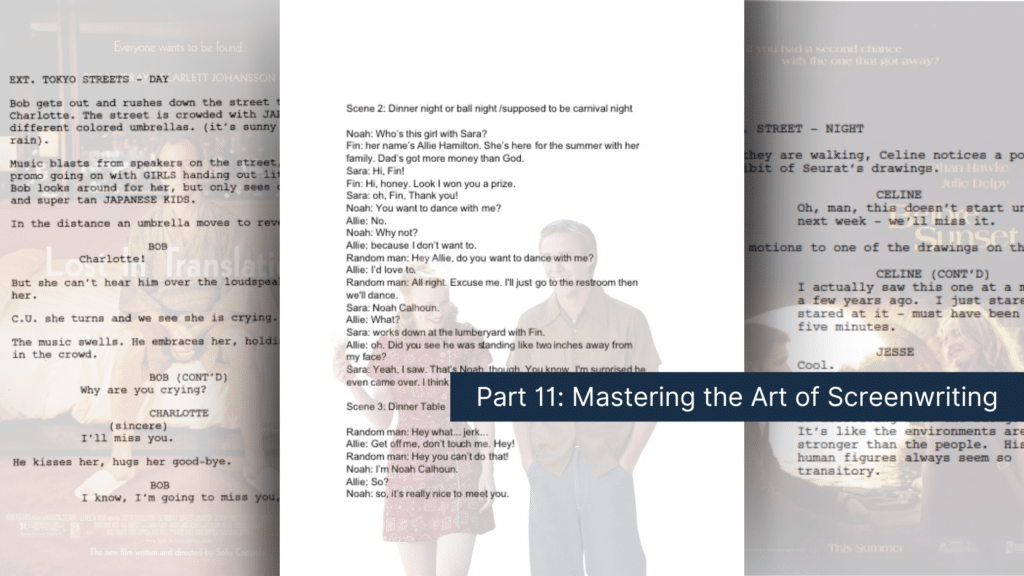
This is part 11 of the Celtx Screenwriting Series – how to write a script in every genre.
Start from the beginning here.
Romance has captivated audiences for centuries, even before we knew what movies were. From classic literature to the silver screen, it will always remain as one of the most popular genres.
Whether it’s the timeless allure of Casablanca, the heart-wrenching drama of Titanic, or the modern charm of La La Land, love stories are here to stay. But what makes a romance movie truly epic?
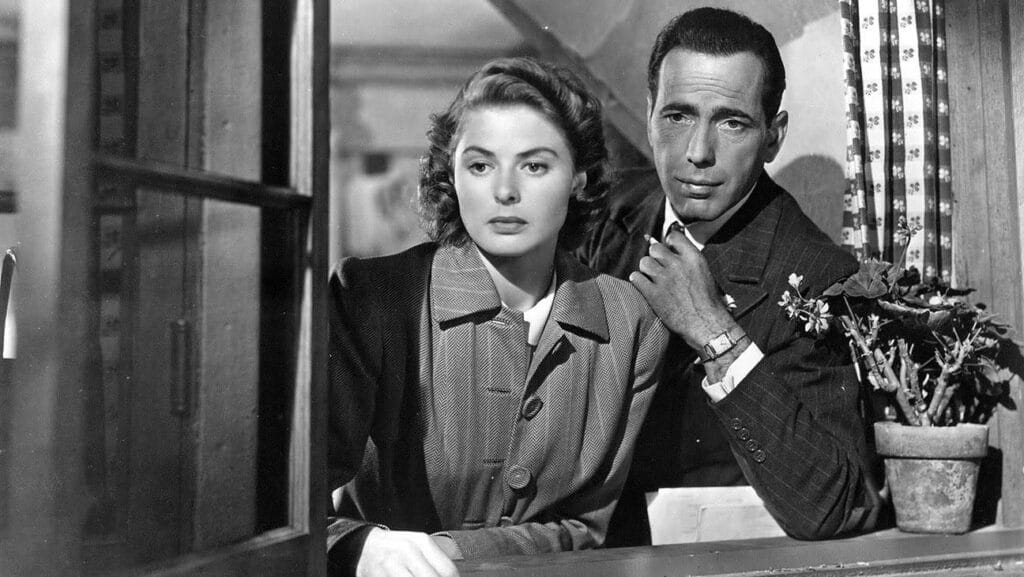
Well, it’s not just a meet-cute followed by a happy ending, we can tell you that much! All romance stories demand emotional depth, well-rounded characters, and a structure that keeps audiences engaged.
If you’ve come from our rom-com post in our Mastering the Art of Screenwriting series, welcome! If not, then you’ve definitely come to the right place if you’re looking to flex your romance writing muscles.
In today’s blog, we’re taking a deep dive into what makes a great cinematic romance, including character development and dialogue, to tropes. We’ll also give you the tools you need to craft your very own romance script that will tug at the heart strings.
The Core of a Great Romance Story
A great romance isn’t just about two people falling head over heels for each other, but about the obstacles they must overcome. In all stories, conflict fuels tension and keeps the audience invested.
This conflict could come from external forces such as societal pressure, war or class differences. On the other hand, it could be conflict caused by internal struggles like fear of vulnerability or past trauma. External and internal conflict can also both affect a couple’s will to be together. Whatever the conflict, the best love stories thrive on tension and resolution.
Emotional stakes are crucial. What does each character stand to lose if love fails? Is it their sense of self, a lifelong dream, or the chance to have true happiness? Essentially, the higher the stakes, the more compelling the story.
Finally, every romance story must deliver a satisfying resolution for the audience. Remember, this doesn’t necessarily mean a happily-ever-after for your couple; some of the most powerful love stories end in tragedy. Think Brokeback Mountain or Romeo and Juliet. Instead, what matters is that the resolution feels earned and resonates with the characters’ emotional journeys.
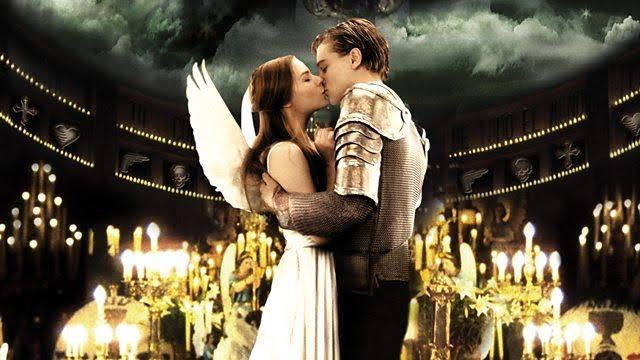
Genre Blending: The Secret Ingredient
Romance rarely stands alone. The very best love stories often blend elements of other genres to create something unique. Here are some of our favorite examples:
Pride and Prejudice (2005) | Historical Romance
The Notebook (2004) | Romantic Drama / Historical Romance
10 Things I Hate About You (1999) | Romantic Comedy
The Shape of Water (2017) | Fantasy Romance
What all these examples show is that finding the right blend for your story means understanding the tone and themes you want to explore.
Balancing romance with another genre requires careful consideration. Say you’re writing a romantic comedy; you’ll want to ensure that the humor is organic and enhance the love story rather than overshadow it.
If it’s a romantic thriller, the suspense should intertwine with the relationship’s stakes. The romance should remain central, no matter the genre blend you choose. Of course, you can just stick to romance.
Want to bring your love story to life?
Start writing with Celtx scriptwriting software today.
Character Development: Crafting Compelling Romantic Leads
Great romance films live and die by their characters. Audiences need to root for your romantic leads, so they need to be well-developed and multi-dimensional individuals. Make sure to bear these key considerations in mind:
1. Distinct Personalities
Each character should have unique traits, goals and flaws. Avoid making them perfect as imperfections make them even more relatable.
Take Elizabeth Bennet and Mr. Darcy in Pride and Prejudice. Elizabeth’s wit and independence clash with Mr. Darcy’s pride and social standing, creating engaging tension throughout.
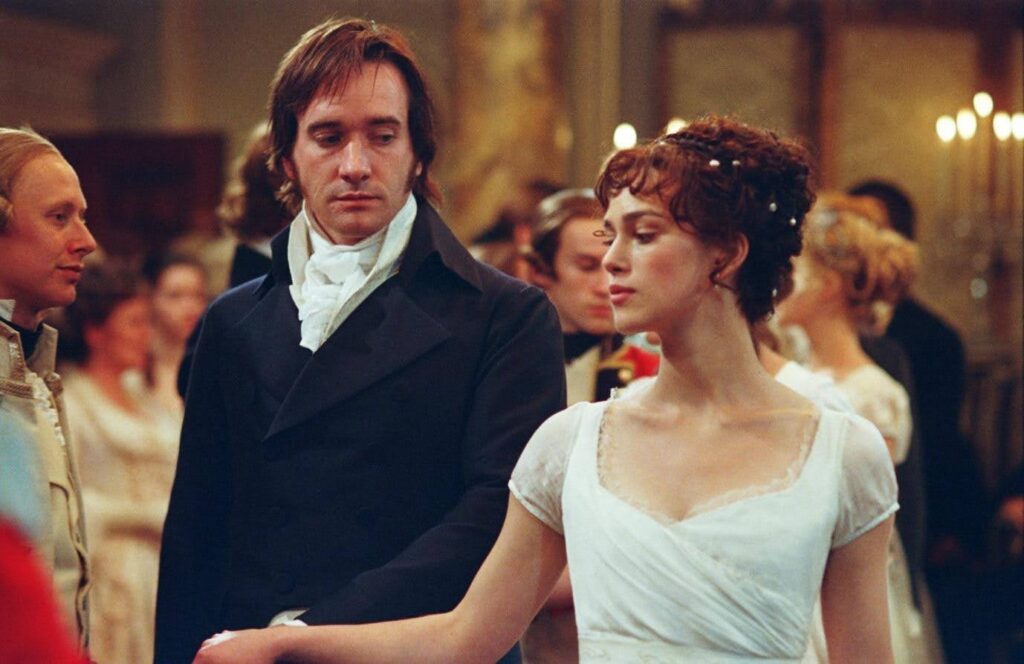
2. Emotional Arcs
A strong love story involves character growth. What does each character learn from the relationship and how does love change them as people? Jack and Rose in Titanic are great examples of how a bond changes them. Jack teaches Rose to embrace life beyond societal expectations, while Rose inspires Jack to believe in love and stability.
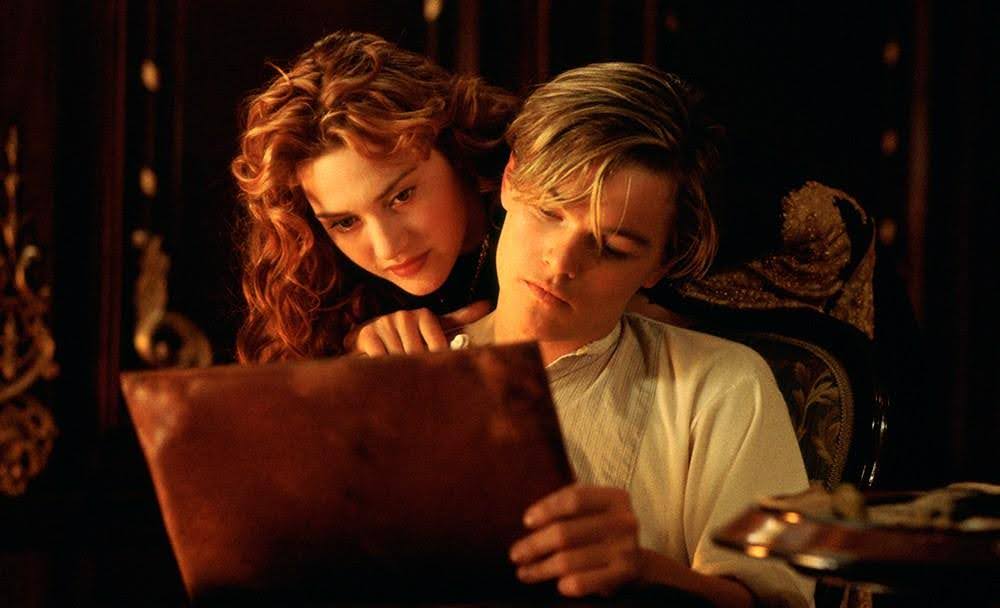
3. Believable Chemistry
Chemistry isn’t just about attraction, but about connection. What makes the two characters click? What do they see in each other that no one else does?
Despite their differences in class and upbringing, Noah and Allie in The Notebook share passion and a deep emotional connection, making their love feel real.
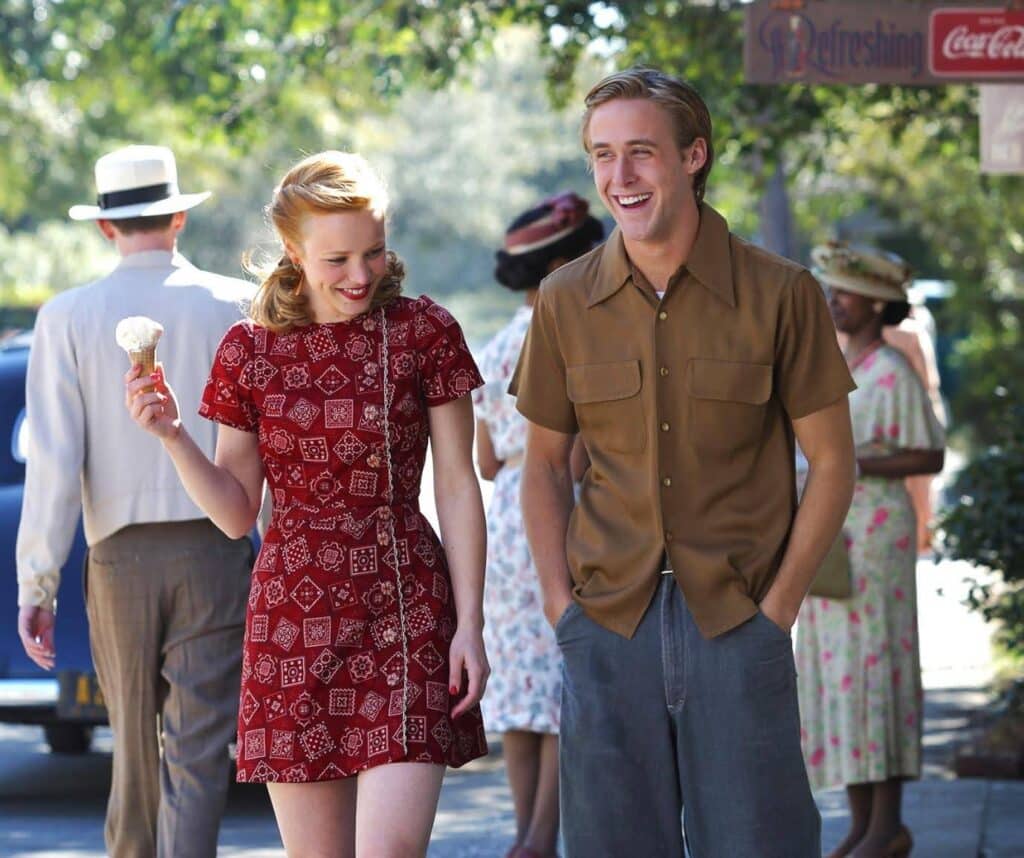
Common Tropes in Romance
Tropes in any genre exist for a reason – they work. But the danger lies in relying on them too much without innovation. If we stick with the same tropes time after time and don’t try and subvert them, the romance in our story can feel extremely predictable.
Let’s take a look at some of the classic romance tropes and how you can subvert them in your story.
Enemies to Lovers
One of the most beloved tropes, the couple in question begin absolutely hating each other, or have seemingly very different goals. As the story progresses, they find themselves coming together. Just like Elizabeth and Mr. Darcy in Pride and Prejudice; their initial disdain for each other transforms into deep love as they learn to see beyond their prejudices.
Unfortunately, this trope can be spotted a mile off. To subvert it, consider making the characters’ conflict deeply personal rather than surface-level rivalry.
Love Triangle
We see it a lot in romance movies – two people fighting it out for another’s affections. Jules in My Best Friend’s Wedding even took it to the extreme, desperately trying to break up best friend Michael’s wedding to Kimmy after she realizes she has feelings for him after a decade of friendship.
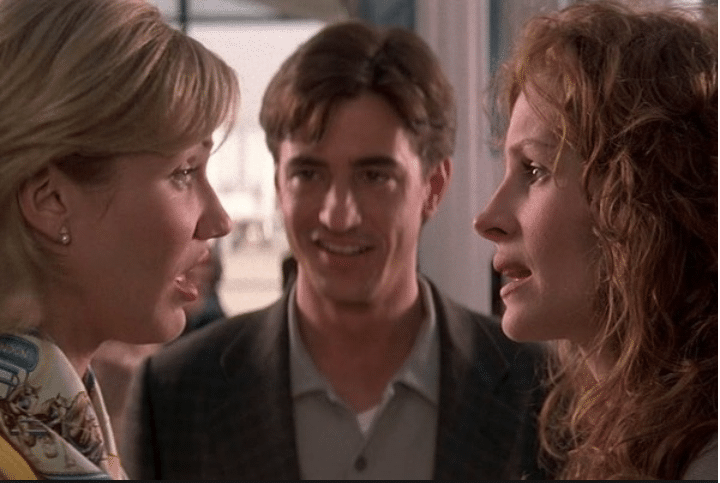
But what if instead of the traditional two-good-options dilemma, both choices reflect different aspects of the protagonist’s inner conflict? Just like Katniss in The Hunger Games who must navigate her feelings for Peeta and Gale, who represent different futures and values.
Fated Love
Destiny-driven romance can be compelling, but adding an element of choice can make it more impactful and satisfying to an audience.
In Before Sunrise, Jesse and Céline’s connection feels fated from the moment they lay eyes on one another, but the actual relationship that stems from that connection is shaped by the choices they make in the moment.
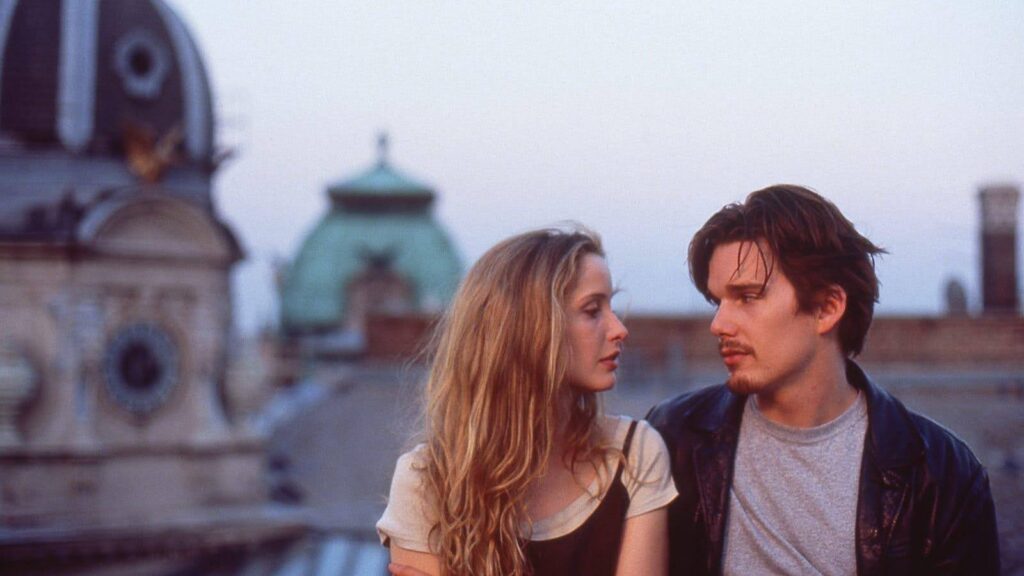
The key when subverting tropes is to think about what audiences expect, then twist it to keep things fresh.
Your screenplay deserves the best tools. Try Celtx free for seamless scriptwriting.
Structuring your Romance Script
Like any good film, romance scripts need a solid structure. Let’s take a look at a classic framework you can recreate for your next project with some help from some of the best romance movies Hollywood has to offer:
1. Inciting Incident
The moment that sparks the love story. This could be a chance encounter, an arranged marriage, or an old flame returning.
In Titanic, Jack and Rose first meet when he saves her from jumping off the ship’s railing, setting their love story in motion.
2. Meet-Cute
A memorable first interaction that sets the tone for the rest of the movie. This moment should reflect the characters’ personalities and hint at the journey ahead.
William and Anna’s first meeting in Notting Hill is a literal collision when he spills orange juice on her, creating an awkward yet charming moment.
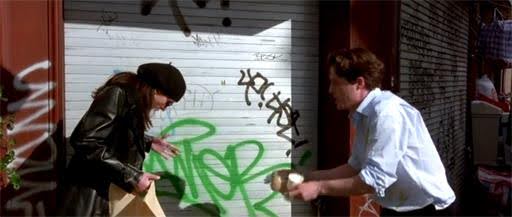
3. Rising Tension
The obstacles that prevent the relationship from being a breeze. As we discussed earlier in the blog, these obstacles could be personal insecurities, external pressures or miscommunications.
Returning to Pride and Prejudice, Elizabeth and Darcy’s misunderstandings and social expectations create ongoing tension in their relationship.
4. Climax
The emotional high point where everything is on the line. Will the couple confess their love for one another? Will they overcome the obstacles?
A great example of climax in a story is Noah and Allie’s intense argument in the rain in The Notebook that leads to a passionate confession of love.
What is climax in film?
In film, the climax is the most intense, dramatic, or pivotal moment of a story, typically occurring near the end. It’s the turning point where the main conflict reaches its peak, leading to resolution. The climax delivers the highest emotional stakes, often determining the protagonist’s fate and the outcome of the narrative.
5. Resolution
The conclusion, whether it’s a grand romantic gesture, a bittersweet farewell, or an unexpected reunion.
The final moments of La La Land show Sebastian and Mia sharing a final look, acknowledging the love they had, even though they ended up on different paths.
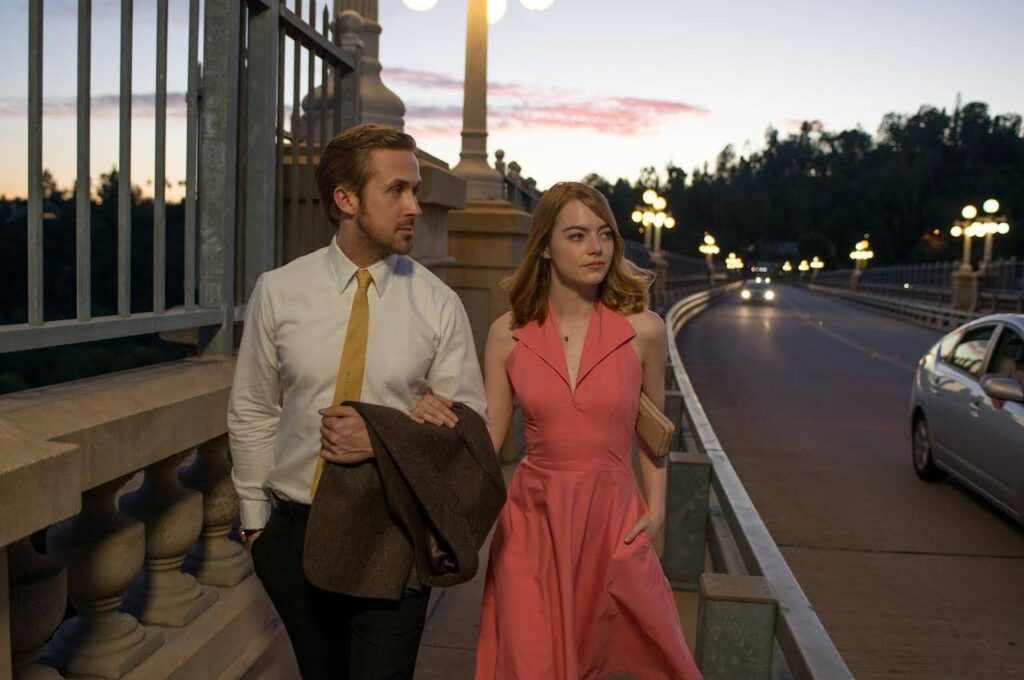
Dialogue and Chemistry
Authentic chemistry between characters isn’t just about longing gazes and passionate kisses, but about how characters communicate.
Writer C.J. Spataro explains how she creates chemistry in our exclusive interview:
Chemistry is all about the subtlety—the things unsaid, the tension in the pauses. When I write love scenes or romantic dialogue, I think about pacing. Too much too soon feels forced, but too little and you risk losing the reader’s investment.
– C.J. Spataro
When you’re crafting dialogue for your next romantic script, here are some things you need to focus on.
- Natural dialogue that’s not overly scripted. This is especially effective in Before Sunrise; the conversations shared between Jesse and Céline feel spontaneous and authentic, making their connection more believable. Take a look at this excerpt from the screenplay:
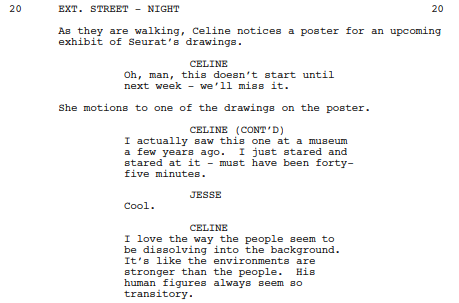
- Make sure to reveal character dynamics through your dialogue (banter, vulnerability, tension).
In When Harry Met Sally, the witty exchanges between the titular characters highlight their evolving relationship and chemistry:
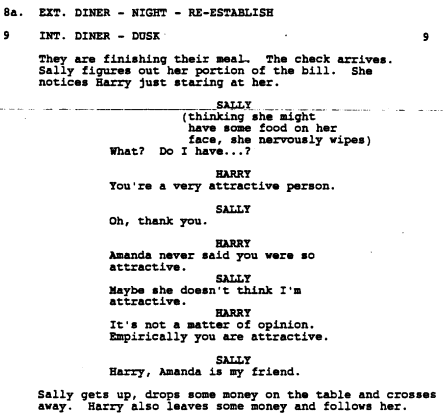
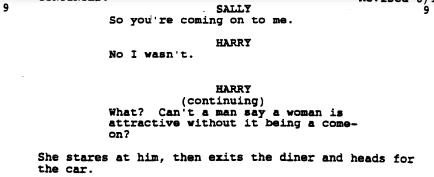
- Use subtext. Remember, what’s not said is just as important as what is! This works extremely well in Lost in Translation where the final whispered words between Bob and Charlotte leave an emotional impact without revealing everything explicitly:
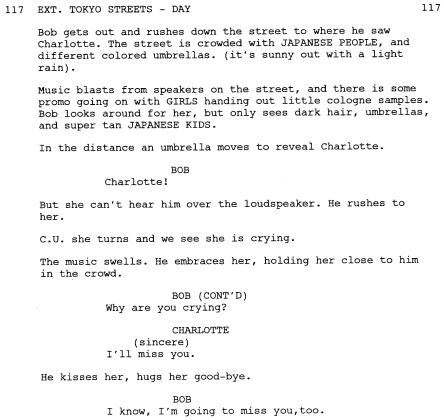
Most importantly, avoid overly poetic, unrealistic speeches unless it fits a character’s personality. Instead, focus on creating dialogue that feels personal and emotionally resonant.
Related Reading- Writing Subtext: How to Say More by Saying Less || Celtx Blog
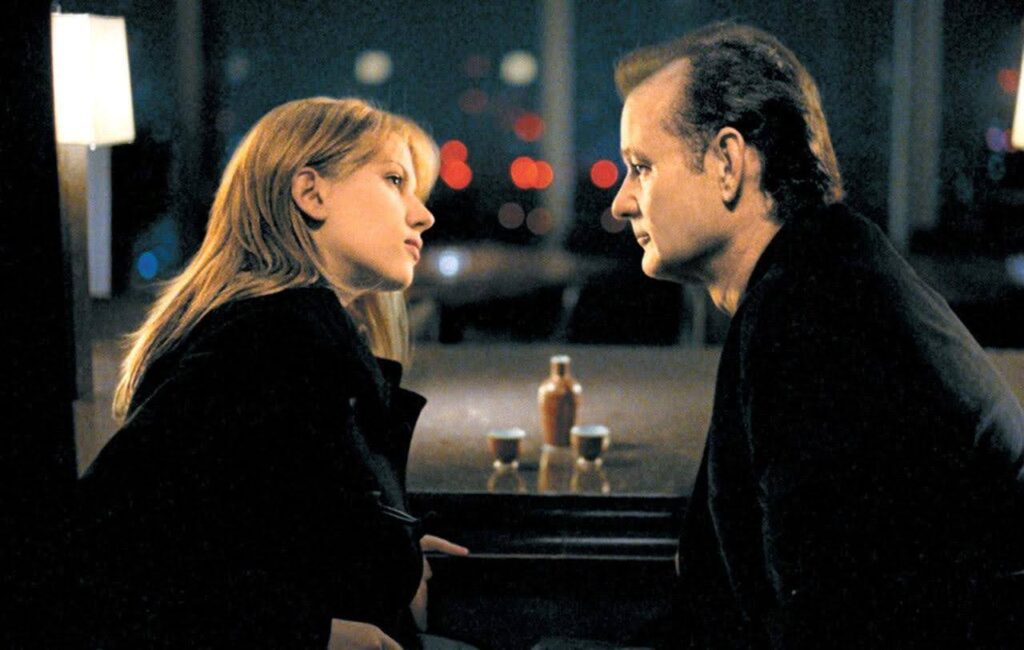
Want to know more about writing realistic dialogue? We have a blog for that! Click here for our top 10 tips to write dialogue that feels real.
Celtx Tools That Help You Craft Your Romance Script
Writing romance requires careful planning and revision, just like any other screenplay. Here at Celtx, we offer tools that can help streamline your creative process.
Our Scriptwriting Software helps you format your script professionally. Once you’ve written your script, visualize the key romantic moments and pacing using our storyboarding features (we even have free storyboard templates).
If you’re writing with a colleague or in a team, our collaboration tools are ideal for co-writing or receiving feedback from your peers.
Also keep organized with our production catalog, where you can save locations, assets and character profiles, so you can keep track of absolutely everything!
Check out how you can kickstart your next romantic script with Celtx here!
Conclusion
Writing a romance film that stands the test of time requires more than just two people falling in love. It’s about conflict, character growth, and delivering an emotionally resonant journey.
By blending genres, developing strong leads, structuring your script effectively, and using tools like Celtx, you can craft a love story that truly shines.
Start your screenwriting journey today.
Try Celtx for free!
Catch up with the rest of the Celtx Screenwriting Series:
- Part 1: Intro to Mastering the Art of Screenwriting
- Part 2: From Dreams to Screams: How to Write a Horror Script
- Part 3: From Dreams to Screams: How to Write a Horror Script Part 2
- Part 4: Beyond the Stars: How to Write a Science Fiction Script
- Part 5: Laugh Out Loud: How to Write a Comedy Script
- Part 6: From Tears to Triumphs: How to Write a Drama Script
- Part 7: From Meet-Cutes to Happy Endings: How to Write a Rom-Com Script
- Part 8: Crafting Magic: How to Write a Holiday Movie Script
- Part 9: How to Write a Documentary Script: A Step-by-Step Guide
- Part 10: How to Write a Skit That Lands Every Time
- Part 12: From Clues to Conclusions: How to Write a Mystery Script
- Part 13: From Song to Stage: How to Write a Musical Script
